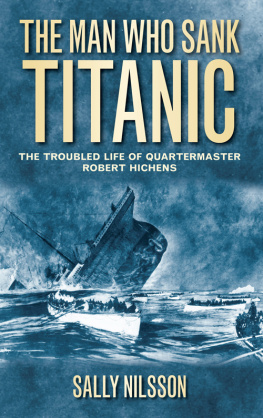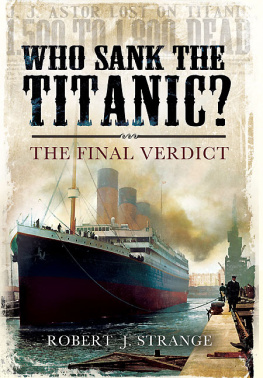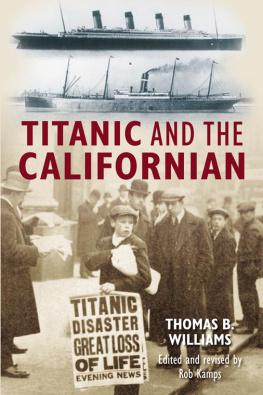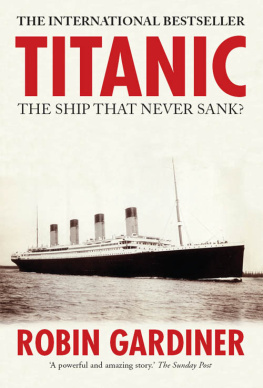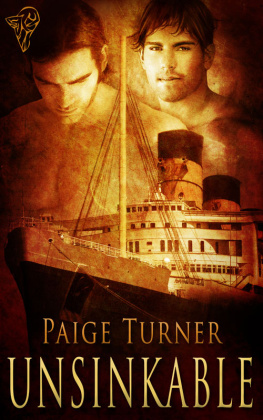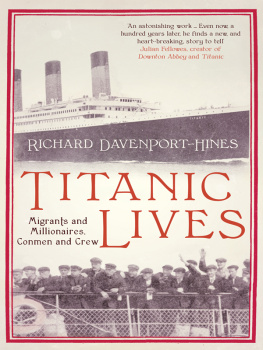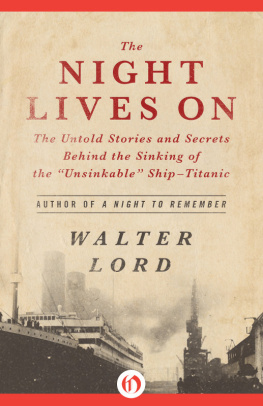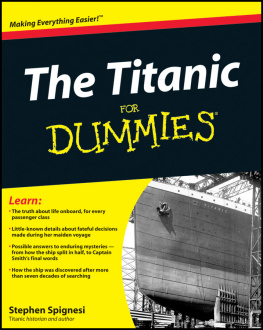
This book is dedicated to all my family and especially to my boys my wonderful husband Paul and my sons Hugo and Henry.


I am very grateful to everyone who has helped me in the writing of this book. I would like to thank the following people: George Behe who spent a considerable amount of time sending me information and advising and sharing his huge knowledge of Titanic; Don Lynch who sent me newspaper articles and the letter that I have based the story around; Phillip Gowan who wrote the original biography of Robert Hichens and helped me so much on the family history Professor Kenneth Plummer from Exeter University who advised me on the complicated subjects of memory and life writing; Louise Berridge, writer and former BBC television producer who I met at The Festival of Writing, who gave advice and encouragement right from the start; Pam Lomax from The Newlyn Archive Centre whose book Newlyn Before the Artists Came and advice was so helpful for writing Roberts early life story; Richard Woodman, author of More Days, More Dollars, for helping me with valuable crew research; Maria Newbery, Curator of Southampton Maritime Museum, for taking time out of her busy schedule to supply me with important photographs, and thanks too to her colleagues from Southampton Library; Michael Pocock of Maritime Quest for letting me use so many of his photographs of crew and Molly Brown; Bill Wormstedt and Rob Ottmers for letting me use the ice chart and for their excellent work on The Titanic Project; Jonathan from The Titanic Research and Modelling Association for his advice and encouragement; David Brown, author of Last Log of The Titanic, for sending me his detailed account of his theories on the collision; David Bryceson for sending me over images from his book The Titanic Disaster as reported in the British Press; Dave Gittins who put me right about helm orders and lots of other useful research; John Chittenden who helped to explain the turning circle of a ship and made a chart for me; Tad Fitch for his Titanic passenger information; Tom Golembiewski who sent me very interesting articles about Robert from the Chicago press, and for his encouragement; Brian Ticehurst for his help and the useful information he sent me; Dennis Skillicorn, former Southampton BBC radio presenter, who gave me taped interviews of survivors, his harrowing account of his experience of hypothermia and books on the port city; Steph Roundsmith for sending me a copy of the Daily Mail from 20 April 1912; Rick Parsons for his image of Newlyn in the nineteenth century.
And, not forgetting, all my family. I have met so many family members who I didnt know I had and will keep in contact with them from now on: Michael Dyer and family; Neil Swanny Swanson; Elizabeth Cutler who emigrated to Australia; and all from Newlyn. Thanks to Peter and Barbara Clarke in Torquay; to my relatives from Southampton (a huge thank you to Gloria Carey for finding the long-lost photos of Roberts children hidden in the back of her garage); my cousin Amanda Reeves; Sue Neale; Ching and her son, Robert Hichens; also John and Gary Holden. A big thank you to my family who have been so patient and supportive while I have been writing as well as being a mum, wife, daughter and taxi driver.
Thank you.
Sally Nilsson

CONTENTS



At 11.40p.m. on Sunday 14 April 1912, First Officer William Murdoch shouted the order Hard-a-Starboard! to Robert Hichens. For those not nautically minded, starboard means right and port means left. Robert Hichens was the quartermaster and helmsman who, having received the Hard-a-Starboard order, spun the wheel as far as it would go in a desperate attempt to steer Titanic away from an iceberg that had been spotted by two lookouts high up in the crows nest. Titanic had been travelling at almost her full speed of 22.5 knots and by the time the iceberg was seen by Murdoch it was less than 500yds away. With the helm hard over Titanic veered two points to port but it was not enough for the 882ft-long, 46,000-ton luxury liner to avoid the ice in time. Titanic caught the iceberg with a glancing blow on her starboard bow, resulting in such catastrophic damage that the ship foundered and, just over two and a half hours later, she sank. Around 705 passengers and crew were destined to survive but 1,523 perished that night on the freezing north Atlantic.
Robert Hichens, my ancestor, was put in command of lifeboat 6 and given direct orders to row to a ship (thought to be a steamer 5 miles away) to offload his passengers and return. Attempts to reach the steamer failed, though, as her lights moved slowly away into the distance and disappeared. While resting in their lifeboat more than half a mile from where the Titanic foundered, as dawn started to break the survivors saw rockets in the direction from where the Titanic had sunk and turned to row towards the rescue ship that had fired them, Carpathia. They had spent more than seven hours at sea and theirs was the final lifeboat to reach the rescue ship. Robert Hichens was the last man to climb the rope ladder behind the passengers he had seen safely aboard.
There were but a handful of men on duty on deck and in the bridge area on Titanic that night. Apart from Robert and William Murdoch they included crows nest lookouts Fleet and Lee, Sixth Officer Moody, Fourth Officer Boxhall and two other quartermasters, Alfred Olliver and George Rowe. The captain, who was always on duty, had been away from the bridge at the time of the collision. Of these men Captain Smith, Moody and Murdoch went down with the ship. The most senior member of Titanic crew to survive the disaster was Second Officer Charles Herbert Lightoller, who would be responsible for telling the world what had happened. He took the stand at both the US and British inquiries and answered hundreds of gruelling questions. Lightoller and more than eighty other witnesses gave their accounts and these statements would be used as the true record for the future, becoming the material for journalists, authors, film producers, historians and researchers for 100 years. The above account is the traditional story of what took place that fateful night. The Titanic tragedy was a terrible accident caused by a set of unforeseen circumstances. But what if some of the accounts given at the inquiries were not the full truth? What if some of the witnesses stood at the stand and lied? Why would they do such a thing?
The world wanted to know why it was that Titanic was steaming at almost her full speed, directly towards a huge ice field with many icebergs surrounding it a deadly obstruction. Many ships had reported the field of ice and bergs in the hours, days and weeks before; four of the ships which were following the same tracks or were just miles away, stuck in the ice or diverting to safer waters, had sent messages to Titanic with these very ice warnings. Why had a highly skilled senior officer failed to spot the iceberg through his binoculars when it was only 500yds away and directly ahead of them? How could this disaster possibly have happened?
Next page
